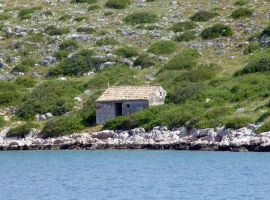At the beginning of the 17th century, the increasing insecurity on the Kornati on one hand (frequent corsair attacks on the flocks, kidnapping of the shepherds for galley rowers), and an increasingly developed and profitable fishing on the other hand, the Kornati became greatly depopulated.
At the beginning of the 17th century, the increasing insecurity on the Kornati on one hand (frequent corsair attacks on the flocks, kidnapping of the shepherds for galley rowers), and an increasingly developed and profitable fishing on the other hand, the Kornati became greatly depopulated. The serfs who had worked for the owners of the islands (the nobility of Zadar) turned to new activities and new locations. The vacuum was filled by the villagers from Murter, Betina and Zaglav, who – as hired colonists for the Zadar nobility – were looking for a new living space. (The Murterini, people from the island of Murter or the village of Murter, were first mentioned on the Kornati in 1627.) The island of Murter became overpopulated because of the refugees before the Turks on the mainland and couldn't feed that number of people. Economically speaking, there were two kinds of residents on the Kornati at the time: 1) peasants and shepherds from Murter, and 2) fishermen from Sali.
 From the arrival of the new colonists to the end of the 19th century, almost nothing changed in the situation on the Kornati. The documents about the life on the Kornati are very scarce. During that period the first peasant and shepherd dwellings (stanovi) were built – small rural complexes located along the field edges on the Kornati. The cadastral maps from 1824-30 show 187 colonists with their domicile in the village of Murter. The records are mainly for the interior of the islands (not on the shore). However, it's important to note that documents already mention in 1682 that the Murterini, the residents of Pašman Island as well as those from the adjacent mainland "bother" the fishermen from Sali. The conflict about the fishing rights in the Kornati only grew since then.
From the arrival of the new colonists to the end of the 19th century, almost nothing changed in the situation on the Kornati. The documents about the life on the Kornati are very scarce. During that period the first peasant and shepherd dwellings (stanovi) were built – small rural complexes located along the field edges on the Kornati. The cadastral maps from 1824-30 show 187 colonists with their domicile in the village of Murter. The records are mainly for the interior of the islands (not on the shore). However, it's important to note that documents already mention in 1682 that the Murterini, the residents of Pašman Island as well as those from the adjacent mainland "bother" the fishermen from Sali. The conflict about the fishing rights in the Kornati only grew since then.
Murterini as owners
At the end of the 19th century, the Zadar nobility as the owners of the islands in the Kornati – and because of the new agrarian policies in Dalmatia – were not able to pay the taxes and duties anymore and they sold all the islands. The Murterini bought the island of Žut in 1885, and, together with the people of Betina and Zaglav, the island of Kornat with all the associated islands in 1896. The residents of Murter Island so became the owners of more than 90% of the land in the Kornati. The people from Sali still paid attention only to the sea because of their traditional and written fishing rights they held throughout the history of the islands.




